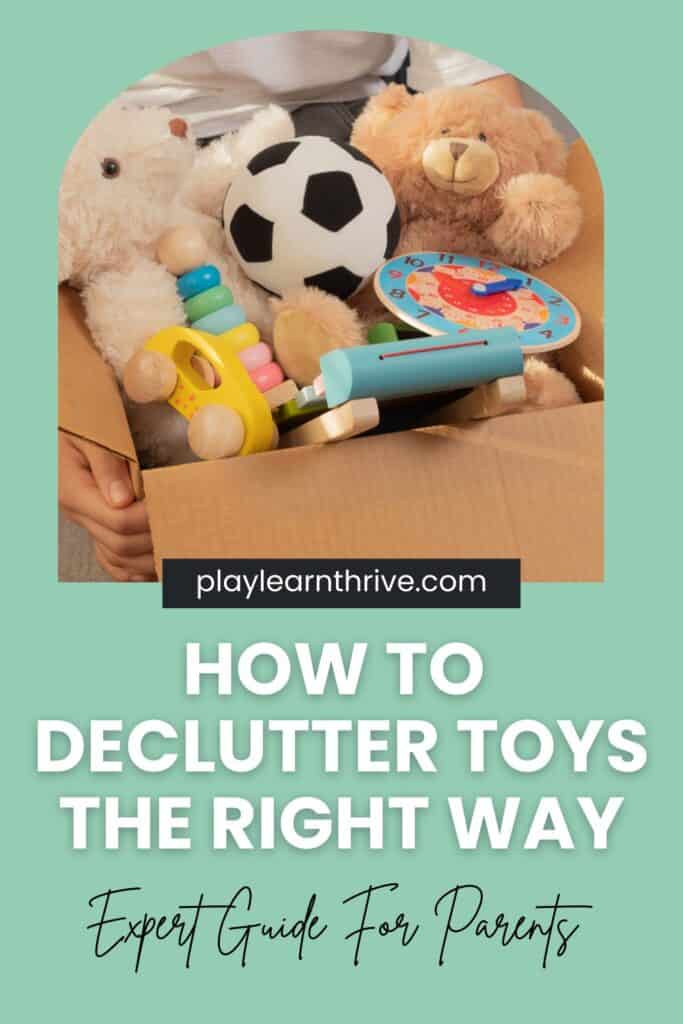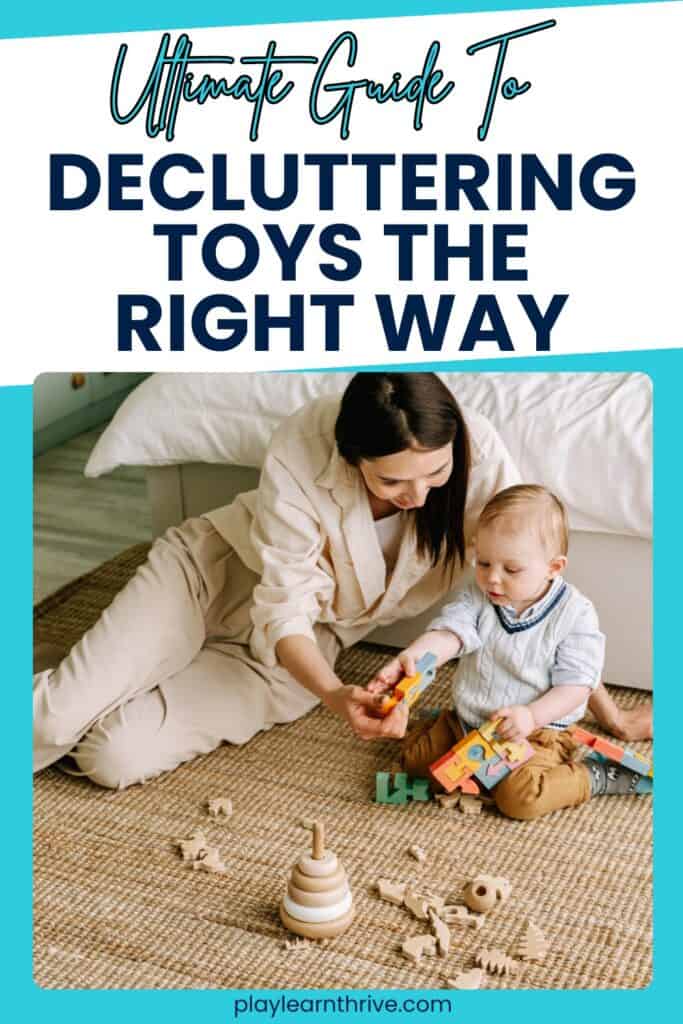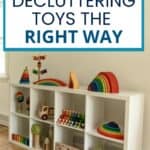Expert Guide on How to Declutter Toys The Right Way
Less is more for mother things in life and toys are no exception. If you are tired of the constant mess in your home because of the overflowing toys, I am going to teach you not only how to declutter toys but also what to do after you declutter the toys.
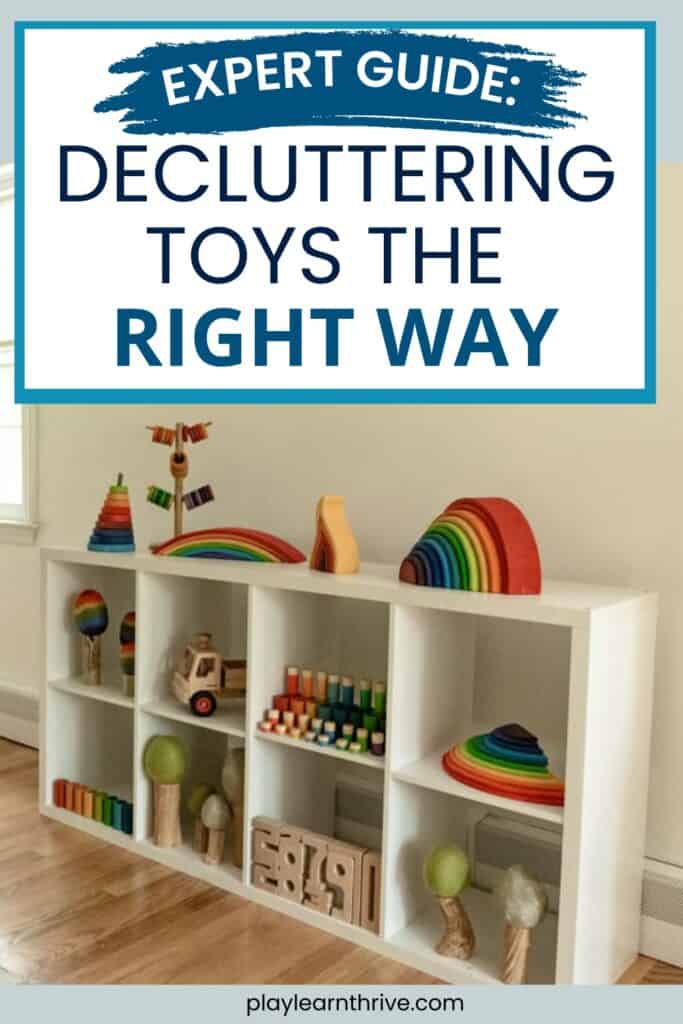
Play. Learn. Thrive.™ only endorses products we authentically love and use. Some of the product links in this post may be affiliate links. That means that if you click them and make a purchase, this site makes a commission. Play. Learn. Thrive.™ is also an Amazon Associate. As an Amazon Associate, we earn from qualifying purchases. It will have no impact on the price you pay or the experience of your purchase.
This post is a step-by-step guide for exactly what to do with the toy mountain in your home!
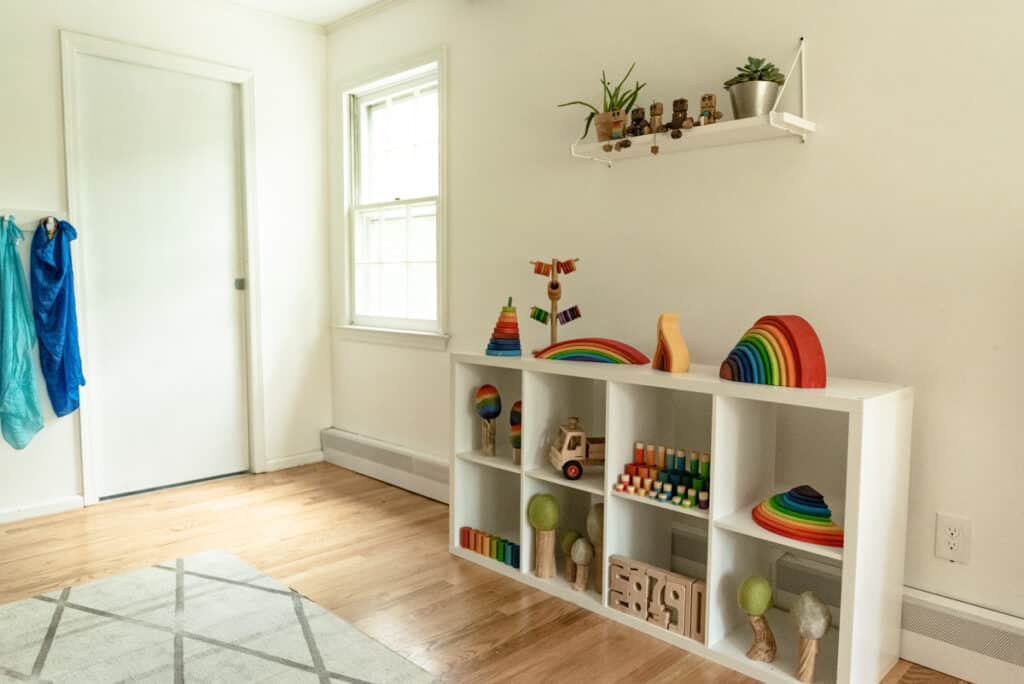
Why Fewer Toys is Better for Your Child
I am a team fewer toys = more play. Yes, you heard that right. But why?
Fewer toys mean bigger benefits for your child. When kids aren't drowning in a sea of toys, they can dive into imaginative play without feeling overwhelmed. They can focus better, get creative, and engage more deeply in their play with less clutter.
Picture this: your kids playing without you for longer periods of time, going deeper in their exploration of the play materials, and improving their problem-solving skills—all thanks to having fewer distractions.
Plus, kids naturally develop better organizational skills with fewer toys to manage, setting them up for success later on.
So, it's not about having the most toys; it's about encouraging quality play that nurtures your child's cognitive and social development in the best possible way.
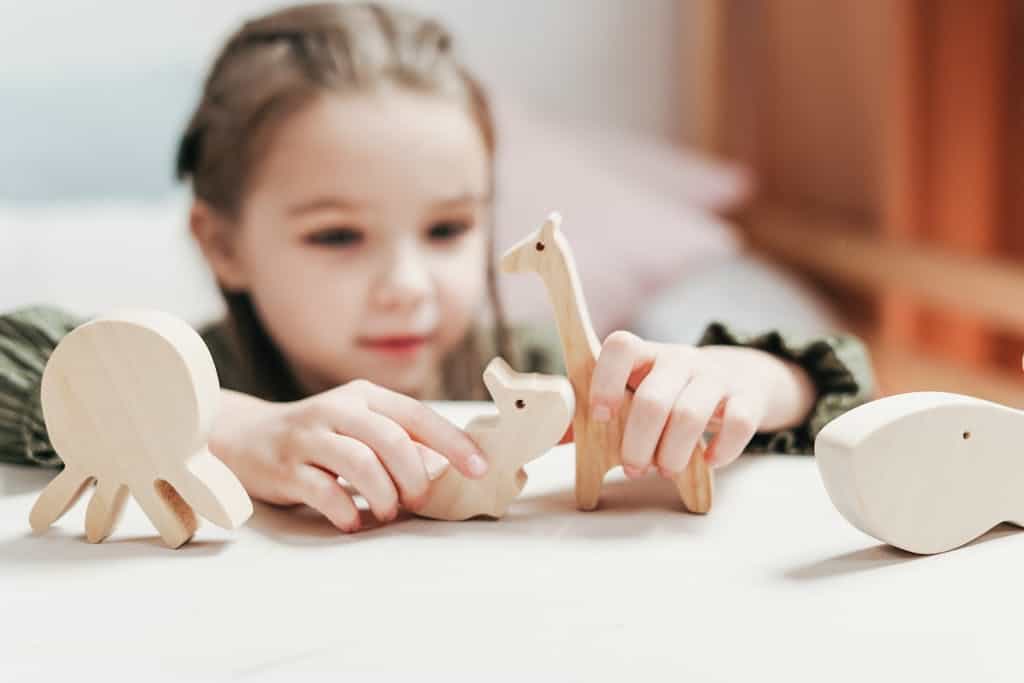
Why Decluttering Matters
Decluttering isn't just about tidying up—it's a game-changer for adults, too. Clearing out the excess reduces stress and overwhelm, leaving room for more in your day—no more toy mountains.
With a decluttered space, efficiency, and productivity skyrocket, making daily life easier and freeing up valuable time for what truly matters–spending time together. Plus, maintaining a clean and organized home becomes a walk in the park, leading to enhanced mental and emotional well-being for everyone involved.
But it's not just about you—by modeling a simplified lifestyle, you're teaching your children valuable lessons in intentional living.
Also, let's not forget the cherry on top: less clutter leads to a much more relaxing space.
So, roll up your sleeves and declutter like there's no tomorrow—it's not just about clearing out the clutter; it's about reclaiming your sanity and creating a haven for your loved ones to thrive. I will walk you through exactly how to do this below!
How to Declutter Toys
Now that you are sold (I hope) let’s get to how to actually do the thing. I am going to share what my personal rules are for decluttering, along with my 3-step system for decluttering toys efficiently.
Rules for Decluttering Toys
When it comes to decluttering toys, it's time to lay down some ground rules—no BS, just straightforward guidelines to clear the chaos and reclaim your space.
Rule number one: evaluate the toys strategically.
Ask yourself, do the kids actually play with them, or are they just taking up valuable real estate? Are they annoying or simply entertaining your kids without them having to do the work? And most importantly, do they encourage useful skills or just add to the clutter?
If the answer isn't a resounding “yes,” it's time for those toys to hit the road.
Here's the kicker: aim to declutter at least 80% of your kids' toys to reap the maximum benefits.
Trust me, it's not about quantity; it's about quality play and creating a space where creativity can thrive. So, channel your inner minimalist and let go of the excess—it's time to declutter like a boss and transform your space into a haven for meaningful play (because remember play is how kids learn ALL the things).
The Three-Step Process for Decluttering Toys
Step 1: Bring all toys into one spot.
Gather every toy scattered around your home and corral them into one central spot. This step might reveal just how many toys your kids actually have, so prepare yourself mentally. Be ready to bid farewell to about 80% of the stash.
Step 2: Categorize by type.
Sort the toys into categories like dolls, trucks, kitchen playsets, balls, and stuffed animals. Also, identify broken or abandoned toys and those that do more than 10% of the work in play scenarios.
Step 3: Purge.
Now comes the tricky part: it's time to purge. Say goodbye to anything broken or not used. Reduce categories because, let's be real, you don't need 20 dump trucks. Stick to the 90/10 rule: keep toys that encourage 90% child-driven play and ditch the ones that do more than 10% of the work. With this systematic approach, you'll streamline your toy collection and create space for more meaningful play experiences.
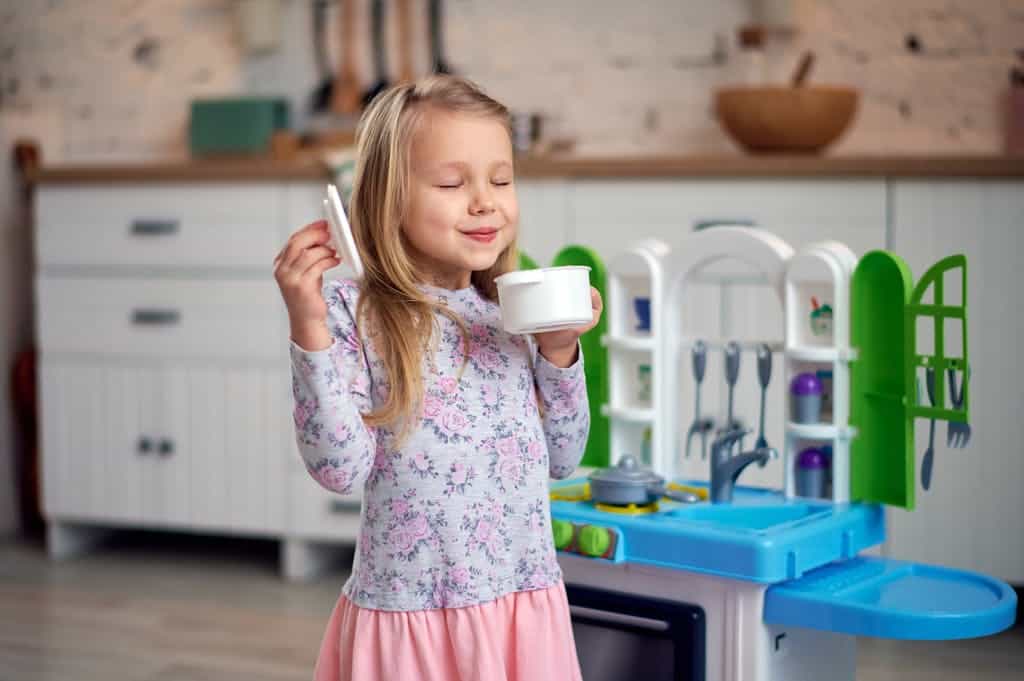
50 Simple Screen-Free Learning Activities for Curious Kids
These 50 hands-on activities help children develop problem-solving skills, creativity, and real-world knowledge—without needing a screen. Designed to encourage self-directed play, hands-on discovery, and deep learning, this guide gives you a simple way to turn everyday moments into powerful learning opportunities.
What to do After You Declutter Toys
After decluttering, you have two options: keep all of the toys out at eye level and in open-face storage containers, or develop a toy rotation system.
Personally, I prefer decluttering to the point of not needing a rotation system. However, if you would like to avoid throwing away so much of your hard-earned money, a rotation system works as well.
Here is a quick breakdown of how to put together a toy rotation system:
- Sort and Categorize Toys: Begin by gathering all of your child’s toys in one space and sorting them into categories. These could include blocks, puzzles, dolls, pretend play items, art supplies, and more. Take note of any toys that are no longer played with, broken, or outgrown, and consider donating or discarding them to streamline the process.
- Choose a Storage Solution: Once you've sorted the toys, select a storage system for the ones that won’t be in immediate rotation. This could be bins, baskets, or plastic containers that can be easily tucked away in a closet, under a bed, or on shelves. Labeling each container can help you quickly identify what’s inside for future rotations. Keep it simple—accessible storage means you’ll be more likely to stick with the system.
- Decide on a Rotation Schedule: The frequency of toy rotations depends on your child’s interests and attention span. Some families rotate toys every week, while others find that a monthly schedule works better. The key is to be flexible—if your child seems to lose interest in the current set of toys, it’s time to swap them out. However, if they are deeply engaged with a certain group, there’s no need to rush the rotation.
- Involve Your Child: For older children, involving them in the rotation process can build anticipation and excitement. Let them help decide which toys to bring out or put away. This also gives them a sense of ownership over their toys and can teach valuable organizational skills.
- Create Space for Imagination: The beauty of a toy rotation system is that it encourages creativity. With fewer toys available, children are more likely to engage deeply with what’s in front of them, often using the same items in new and imaginative ways. You might be surprised to see how much they can do with a smaller selection of toys.
Toy rotation doesn’t have to be complicated, and the benefits can be tremendous. It reduces toy overload, keeps your space clutter-free, and gives your child a renewed sense of excitement with each rotation. It’s a great compromise if you're not ready to declutter to the point of having minimal toys but still want to simplify your home and your child’s playtime experience.
Inspired by this post? Be sure to subscribe download my free Screen-Free Starter Kit! For more insights and resources on raising confident, lifelong learners, be sure to follow me on Instagram – can't wait for you to join me!

